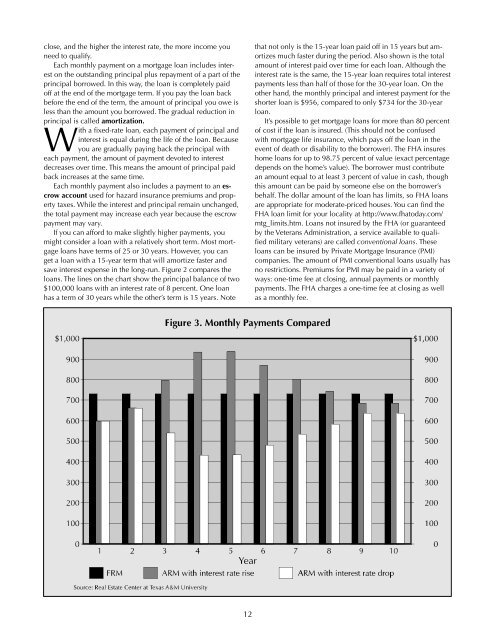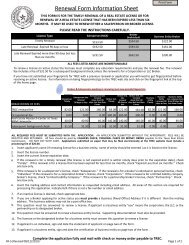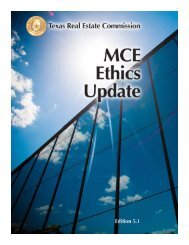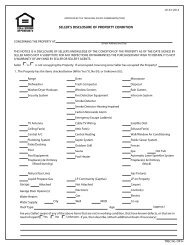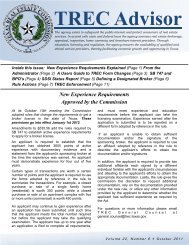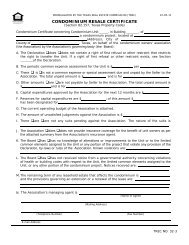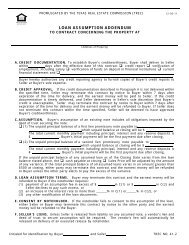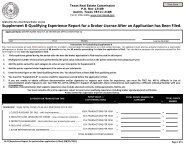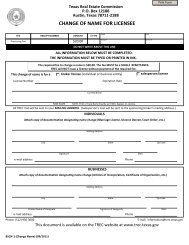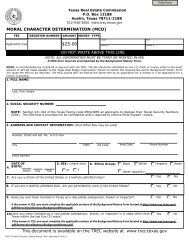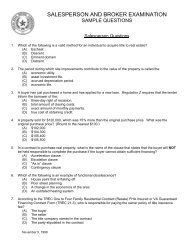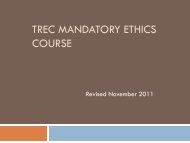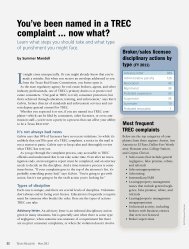Homebuyer's Guide - Real Estate Center - Texas A&M University
Homebuyer's Guide - Real Estate Center - Texas A&M University
Homebuyer's Guide - Real Estate Center - Texas A&M University
You also want an ePaper? Increase the reach of your titles
YUMPU automatically turns print PDFs into web optimized ePapers that Google loves.
close, and the higher the interest rate, the more income you<br />
need to qualify.<br />
Each monthly payment on a mortgage loan includes interest<br />
on the outstanding principal plus repayment of a part of the<br />
principal borrowed. In this way, the loan is completely paid<br />
off at the end of the mortgage term. If you pay the loan back<br />
before the end of the term, the amount of principal you owe is<br />
less than the amount you borrowed. The gradual reduction in<br />
principal is called amortization.<br />
With a fixed-rate loan, each payment of principal and<br />
interest is equal during the life of the loan. Because<br />
you are gradually paying back the principal with<br />
each payment, the amount of payment devoted to interest<br />
decreases over time. This means the amount of principal paid<br />
back increases at the same time.<br />
Each monthly payment also includes a payment to an escrow<br />
account used for hazard insurance premiums and property<br />
taxes. While the interest and principal remain unchanged,<br />
the total payment may increase each year because the escrow<br />
payment may vary.<br />
If you can afford to make slightly higher payments, you<br />
might consider a loan with a relatively short term. Most mortgage<br />
loans have terms of 25 or 30 years. However, you can<br />
get a loan with a 15-year term that will amortize faster and<br />
save interest expense in the long-run. Figure 2 compares the<br />
loans. The lines on the chart show the principal balance of two<br />
$100,000 loans with an interest rate of 8 percent. One loan<br />
has a term of 30 years while the other’s term is 15 years. Note<br />
that not only is the 15-year loan paid off in 15 years but amortizes<br />
much faster during the period. Also shown is the total<br />
amount of interest paid over time for each loan. Although the<br />
interest rate is the same, the 15-year loan requires total interest<br />
payments less than half of those for the 30-year loan. On the<br />
other hand, the monthly principal and interest payment for the<br />
shorter loan is $956, compared to only $734 for the 30-year<br />
loan.<br />
It’s possible to get mortgage loans for more than 80 percent<br />
of cost if the loan is insured. (This should not be confused<br />
with mortgage life insurance, which pays off the loan in the<br />
event of death or disability to the borrower). The FHA insures<br />
home loans for up to 98.75 percent of value (exact percentage<br />
depends on the home’s value). The borrower must contribute<br />
an amount equal to at least 3 percent of value in cash, though<br />
this amount can be paid by someone else on the borrower’s<br />
behalf. The dollar amount of the loan has limits, so FHA loans<br />
are appropriate for moderate-priced houses. You can find the<br />
FHA loan limit for your locality at http://www.fhatoday.com/<br />
mtg_limits.htm. Loans not insured by the FHA (or guaranteed<br />
by the Veterans Administration, a service available to qualified<br />
military veterans) are called conventional loans. These<br />
loans can be insured by Private Mortgage Insurance (PMI)<br />
companies. The amount of PMI conventional loans usually has<br />
no restrictions. Premiums for PMI may be paid in a variety of<br />
ways: one-time fee at closing, annual payments or monthly<br />
payments. The FHA charges a one-time fee at closing as well<br />
as a monthly fee.<br />
12


